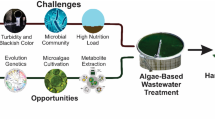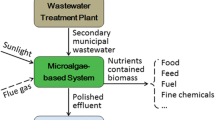Abstract
Cost-efficient and environmentally friendly treatment of hydraulic fracturing effluents is of great significance for the sustainable development of shale gas exploration. We investigated the synergistic effects of plant-microbial treatment of shale gas fracturing waste fluid. The results showed that illumination wavelength and temperature are direct drivers for microbial treatment effects of CODCr and BOD5, while exhibit little effects on nitrogen compounds, TDS, EC, and SS removals as well as microbial species and composition. Plant-microbial synergism could significantly enhance the removal of pollutants compared with removal efficiency without plant enhancement. Additionally, the relative abundance and structure of microorganisms in the hydraulic fracturing effluents greatly varied with the illumination wavelength and temperature under plant-microbial synergism. 201.24 g water dropwort and 435 mg/L activated sludge with illumination of 450–495 nm (blue) at 25 °C was proved as the best treatment condition for shale gas fracturing waste fluid samples, which showed the highest removal efficiency of pollutants and the lowest algal toxicity in treated hydraulic fracturing effluents. The microbial community composition (36.73% Flavobacteriia, 25.01% Gammaproteobacteria, 18.55% Bacteroidia, 9.3% Alphaproteobacteria, 4.1% Cytophagia, and 2.83% Clostridia) was also significantly different from other treatments. The results provide a potential technical solution for improved treatment of shale gas hydraulic fracturing effluents.
Graphical abstract






Similar content being viewed by others
Data availability
All data generated or analysed during this study are included in this published article and its supplementary information files.
References
Blewett TA, Delompre PL, He Y, Folkerts EJ, Flynn SL, Alessi DS, Goss GG (2017) Sub-lethal and reproductive effects of acute and chronic exposure to flowback and produced water from hydraulic fracturing on the water flea Daphnia magna. Environ Sci Technol 51:3032–3039. https://doi.org/10.1021/acs.est.6b05179
Camarillo MK, Stringfellow WT (2018) Biological treatment of oil and gas produced water: a review and meta-analysis. Clean Technol Environ 20:1127–1146. https://doi.org/10.1007/s10098-018-1564-9
Caporaso JG, Lauber CL, Walters WA, Berg-Lyons D, Lozupone CA, Turnbaugh PJ, Fierer N, Knight R (2011) Global patterns of 16S rRNA diversity at a depth of millions of sequences per sample. Proc Natl Acad Sci U S A 108:4516–4522. https://doi.org/10.1073/pnas.1000080107
Caporaso JG, Lauber CL, Walters WA, Berg-Lyons D, Huntley J, Fierer N, Owens SM, Betley J, Fraser L, Bauer M, Gormley N, Gilbert JA, Smith G, Knight R (2012) Ultra-high-throughput microbial community analysis on the Illumina HiSeq and MiSeq platforms. ISME J 6:1621–1624. https://doi.org/10.1038/ismej.2012.8
Casey JA, Savitz DA, Rasmussen SG, Ogburn EL, Pollak J, Mercer DG, Schwartz BS (2015) Unconventional natural gas development and birth outcomes in Pennsylvania, USA. Epidemiology 27:163–172. https://doi.org/10.1097/ede.0000000000000387
Çetin FD, Sürücü G (1990) Effects of temperature and pH on the settleability of activated sludge. Flocs Water Sci Technol 22:249–254. https://doi.org/10.2166/wst.1990.0089
Chen H, Carter KE (2016) Water usage for natural gas production through hydraulic fracturing in the United States from 2008 to 2014. J Environ Manag 170:152–159. https://doi.org/10.1016/j.jenvman.2016.01.023
Chen SS, Sun Y, Tsang DCW, Graham NJD, Yong SO, Feng Y, Li XD (2017) Potential impact of flowback water from hydraulic fracturing on agricultural soil quality: metal/metalloid bioaccessibility, microtox bioassay, and enzyme activities. Sci Total Environ 579:1419–1426. https://doi.org/10.1016/j.scitotenv.2016.11.141
Cho H, Choi Y, Lee S (2018) Effect of pretreatment and operating conditions on the performance of membrane distillation for the treatment of shale gas wastewater. Desalination 437:195–209. https://doi.org/10.1016/j.desal.2018.03.009
Coday BD, Cath TY (2014) Forward osmosis: novel desalination of produced water and fracturing flowback. J Am Water Work Assoc 106:E55–E66. https://doi.org/10.5942/jawwa.2014.106.0016
Durant B, Abualfaraj N, Olson MS, Gurian PL (2016) Assessing dermal exposure risk to workers from flowback water during shale gas hydraulic fracturing activity. J Nat Gas Sci Eng 34:969–978. https://doi.org/10.1016/j.jngse.2016.07.051
Edgar RC, Haas BJ, Clemente JC, Quince C, Knight R (2011) UCHIME improves sensitivity and speed of chimera detection. Bioinformatics 27:2194–2200. https://doi.org/10.1093/bioinformatics/btr381
Eikelboom DH (2000) Process control of activated sludge plants by microscopic investigation, 1st edn. IWA Publishing, London
Entrekin S, Evans-White M, Johnson B, Hagenbuch E (2011) Rapid expansion of natural gas development poses a threat to surface waters. Front Ecol Environ 9:503–511. https://doi.org/10.1890/110053
Gillooly JF, Brown JH, West GB, Savage VM, Charnov EL (2001) Effects of size and temperature on metabolic rate. Science 293:2248–2251. https://doi.org/10.1126/science.1061967
Gordalla BC, Ewers U, Frimmel FH (2013) Hydraulic fracturing: a toxicological threat for groundwater and drinking-water? Environ Earth Sci 70:3875–3893. https://doi.org/10.1007/s12665-013-2672-9
Graham J, Irving J, Tang X, Sellers S, Crisp J, Horwitz D, Muehlenbachs L, Krupnick A, Carey D (2015) Increased traffic accident rates associated with shale gas drilling in Pennsylvania. Accid Anal Prev 74:203–209. https://doi.org/10.1016/j.aap.2014.11.003
HACH (2007) DR 2800 spectrophotometer procedures manual. HACH Company, Loveland
He M, Chen WJ, Tian L, Shao B, Lin Y (2019) Plant-microbial synergism: an effective approach for the remediation of shale-gas fracturing flowback and produced water. J Hazard Mater 363:170–178. https://doi.org/10.1016/j.jhazmat.2018.09.058
Igunnu ET, Chen GZ (2014) Produced water treatment technologies. Int J Low Carbon Technol 9:157–177. https://doi.org/10.1093/ijlct/cts049
Kekacs D, Drollette BD, Brooker M, Plata DL, Mouser PJ (2015) Aerobic biodegradation of organic compounds in hydraulic fracturing fluids. Biodegradation 26:271–287. https://doi.org/10.1007/s10532-015-9733-6
Lester Y, Yacob T, Morrissy I, Linden K (2013) Can we treat hydraulic fracturing flowback with a conventional biological process? The case of guar gum. Environ Sci Technol Lett 1:133–136. https://doi.org/10.1021/ez4000115
Lester Y, Ferrer I, Thurman EM, Sitterley KA, Korak JA, Aiken G, Linden KG (2015) Characterization of hydraulic fracturing flowback water in Colorado: implications for water treatment. Sci Total Environ 512:637–644. https://doi.org/10.1016/j.scitotenv.2015.01.043
Li HM, Xu ZG, Tang CM (2010) Effect of light-emitting diodes on growth and morphogenesis of upland cotton (Gossypium hirsutum L.) plantlets in vitro. Plant Cell Tissue Organ Cult 103:155–163. https://doi.org/10.1007/s11240-010-9763-z
Li X, Lu W, Hu GY, Wang XC, Zhang Y, Sun GX, Fang ZC (2016) Effects of light-emitting diode supplementary lighting on the winter growth of greenhouse plants in the Yangtze River Delta of China. Bot Stud 57:2. https://doi.org/10.1186/s40529-015-0117-3
Liu JW, Xue CX, Sun H, Zheng YF, Meng Z, Zhang XH (2019) Carbohydrate catabolic capability of a Flavobacteriia bacterium isolated from hadal water. Syst Appl Microbiol 42:263–274. https://doi.org/10.1016/j.syapm.2019.01.002
Lobo FL, Wang HM, Huggins T, Rosenblum J, Linden KG, Ren ZJ (2016) Low-energy hydraulic fracturing wastewater treatment via AC powered electrocoagulation with biochar. J Hazard Mater 309:180–184. https://doi.org/10.1016/j.jhazmat.2016.02.020
Ma G, Zhang L, Kato M, Yamawaki K, Kiriiwa Y, Yahata M, Ikoma Y, Matsumoto H (2015) Effect of the combination of ethylene and red LED light irradiation on carotenoid accumulation and carotenogenic gene expression in the flavedo of citrus fruit. Postharvest Biol Technol 99:99–104. https://doi.org/10.1016/j.postharvbio.2014.08.002
Mao J, Chong Z, Yang X, Zhang Z (2018) Investigation on problems of wastewater from hydraulic fracturing and their solutions. Water Air Soil Pollut 229:246. https://doi.org/10.1007/s11270-018-3847-5
Martin M, Vandermies M, Joyeux C, Martin R, Barbeyron T, Michel G, Vandenbol M (2016) Discovering novel enzymes by functional screening of plurigenomic libraries from alga-associated Flavobacteriia and Gammaproteobacteria. Microbiol Res 186:52–61. https://doi.org/10.1016/j.micres.2016.03.005
MEP (1996) Integrated Wastewater Discharge Standard, GB8978-1996. China Ministry of Environmental Protection, Beijing
MEP (2015) Emission standard of pollutants for petroleum chemistry industry, GB31671-2015. China Ministry of Environmental Protection, Beijing
Mor G, Kwon J-Y (2015) Trophoblast-microbiome interaction: a new paradigm on immune regulation. Am J Obstet Gynecol 213:S131–S137. https://doi.org/10.1016/j.ajog.2015.06.039
Ncibi MC, Mahjoub B, Mahjoub O, Sillanpaa M (2017) Remediation of emerging pollutants in contaminated wastewater and aquatic environments: biomass-based technologies. Clean (Weinh) 45:1700101. https://doi.org/10.1002/clen.201700101
OECD (2011) Test No. 201: Freshwater Alga and Cyanobacteria, Growth Inhibition Test. OECD Publishing, Paris. https://doi.org/10.1787/9789264069923-en
Purvis RM, Lewis AC, Hopkins JR, Wilde SE, Dunmore RE, Allen G, Pitt J, Ward RS (2019) Effects of ‘pre-fracking’ operations on ambient air quality at a shale gas exploration site in rural North Yorkshire, England. Sci Total Environ 673:445–454. https://doi.org/10.1016/j.scitotenv.2019.04.077
Rice EW, Baird RB, Eaton AD (2012) Standard methods for the examination of water and wastewater, 22rd edn. American Public Health Association, Washington
Riley SM, Oliveira JMS, Regnery J, Cath TY (2016) Hybrid membrane bio-systems for sustainable treatment of oil and gas produced water and fracturing flowback water. Sep Purif Technol 171:297–311. https://doi.org/10.1016/j.seppur.2016.07.008
Rish WR, Pfau EJ (2017) Bounding analysis of drinking water health risks from a spill of hydraulic fracturing flowback water. Risk Anal 38:724–754. https://doi.org/10.1111/risa.12884
Sardari K, Fyfe P, Lincicome D, Wickramasinghe SR (2018) Aluminum electrocoagulation followed by forward osmosis for treating hydraulic fracturing produced waters. Desalination 428:172–181. https://doi.org/10.1016/j.desal.2017.11.030
Servin JA, Herbold CW, Skophammer RG, Lake JA (2008) Evidence excluding the root of the tree of life from the Actinobacteria. Mol Biol Evol 25:1–4. https://doi.org/10.1093/molbev/msm249
Stacy SL (2017) A review of the human health impacts of unconventional natural gas development. Curr Epidemiol Rep 4:38–45. https://doi.org/10.1007/s40471-017-0097-9
Su YY, Mennerich A, Urban B (2012) Synergistic cooperation between wastewater-born algae and activated sludge for wastewater treatment: influence of algae and sludge inoculation ratios. Bioresour Technol 105:67–73. https://doi.org/10.1016/j.biortech.2011.11.113
Sun YQ, Wang D, Tsang DCW, Wang L, Ok YS, Feng YJ (2019) A critical review of risks, characteristics, and treatment strategies for potentially toxic elements in wastewater from shale gas extraction. Environ Int 125:452–469. https://doi.org/10.1016/j.envint.2019.02.019
Torres L, Yadav OP, Khan E (2016) A review on risk assessment techniques for hydraulic fracturing water and produced water management implemented in onshore unconventional oil and gas production. Sci Total Environ 539:478–493. https://doi.org/10.1016/j.scitotenv.2015.09.030
Vandecasteele I, Rivero IM, Sala S, Baranzelli C, Barranco R, Batelaan O, Lavalle C (2015) Impact of shale gas development on water resources: a case study in northern Poland. Environ Manag 55:1285–1299. https://doi.org/10.1007/s00267-015-0454-8
Vidic RD, Brantley SL, Vandenbossche JM, Yoxtheimer D, ., Abad JD (2013) Impact of shale gas development on regional water quality. Science 340:1235009 doi:https://doi.org/10.1126/science.1235009
Vinciguerra T, Yao S, Dadzie J, Chittams A, Deskins T, Ehrman S, Dickerson RR (2015) Regional air quality impacts of hydraulic fracturing and shale natural gas activity: evidence from ambient VOC observations. Atmos Environ 110:144–150. https://doi.org/10.1016/j.atmosenv.2015.03.056
Wang Q, Garrity GM, Tiedje JM, Cole JR (2007) Naïve Bayesian classifier for rapid assignment of rRNA sequences into the new bacterial taxonomy. Appl Environ Microbiol 73:5261–5267. https://doi.org/10.1128/AEM.00062-07
Wu T, Lin Y, Zheng L, Guo Z, Xu J, Liang S, Liu Z, Lu Y, Shih TM, Chen Z (2018) Analyses of multi-color plant-growth light sources in achieving maximum photosynthesis efficiencies with enhanced color qualities. Opt Express 26:4135–4147. https://doi.org/10.1364/OE.26.004135
Xu HL, Xu QC, Li FL, Feng YZ, Qin FF, Fang W (2012) Applications of xerophytophysiology in plant production-LED blue light as a stimulus improved the tomato crop. Sci Hortic 148:190–196. https://doi.org/10.1016/j.scienta.2012.06.044
Zhang D, Yang T (2015) Environmental impacts of hydraulic fracturing in shale gas development in the United States. Pet Explor Dev 42:876–883. https://doi.org/10.1016/S1876-3804(15)30085-9
Acknowledgements
The authors thank the anonymous reviewers for their helpful comments on this work. All the funding body play a major role in the collection of research samples and analysis and testing of samples.
Funding
This work was supported by the National Natural Science Foundation of China [grant number 41472124], PetroChina Innovation Foundation [grant numbers 2015D-5006-0210, 2016D-5007-0702], the Yangtze University Outstanding Doctoral and Master Degree Thesis Cultivation Program Fund [grant number YS2018052], the Yangtze Talents Fund [grant number 2020-2023], the Hubei Provincial Student Innovation and Entrepreneurship Training Program [grant number S202010489042], and the Yangtze University Student Innovation and Entrepreneurship training program [grant number 2019418].
Author information
Authors and Affiliations
Contributions
MH: supervision; project administration; funding acquisition; resources; conceptualization; methodology; writing—review and editing
YL: writing—review and editing
BS: formal analysis; investigation; data curation; visualization; writing—original draft
LT: resources and investigation
WJC, XT, and JLL: investigation
Corresponding authors
Ethics declarations
Ethics approval and consent to participate
Not applicable.
Consent for publication
Not applicable.
Competing interests
The authors declare no competing interests.
Additional information
Responsible Editor: Diane Purchase
Publisher’s note
Springer Nature remains neutral with regard to jurisdictional claims in published maps and institutional affiliations.
Highlights
• Combination of 201.24 g water dropwort and 435 mg/L activated sludge showed best treatment efficiency.
• Illumination and temperature were important drivers for pollutant removal and microbial abundance.
• Blue light illumination at 25 °C was the best condition for enhancing treatment of FW.
• Plant-microbial synergism is proven to be an effective treatment method for FW.
Supplementary information
ESM 1
(DOCX 653 kb)
Rights and permissions
About this article
Cite this article
Shao, B., Tan, X., Li, JL. et al. Enhanced treatment of shale gas fracturing waste fluid through plant-microbial synergism. Environ Sci Pollut Res 28, 29919–29930 (2021). https://doi.org/10.1007/s11356-021-12830-z
Received:
Accepted:
Published:
Issue Date:
DOI: https://doi.org/10.1007/s11356-021-12830-z




